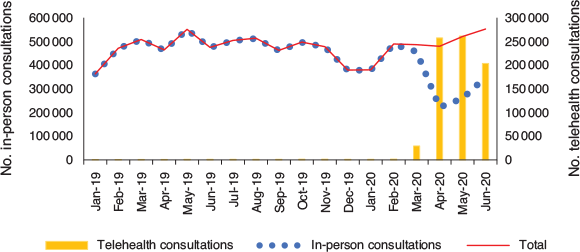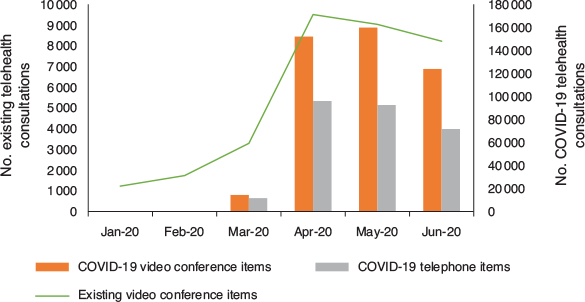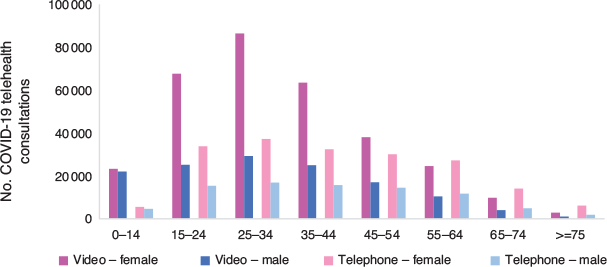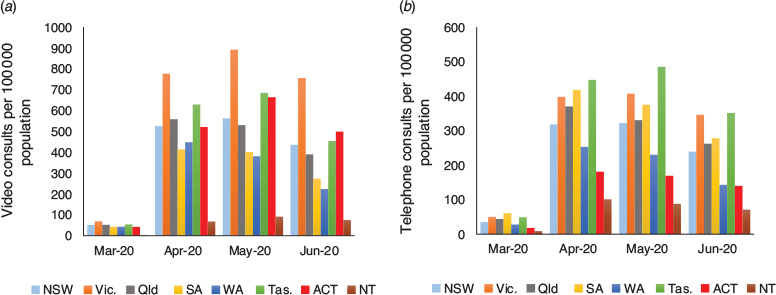Use of telehealth mental health services during the COVID-19 pandemic
Danusha Jayawardana A C and Brenda Gannon A BA Centre for the Business and Economics of Health, Level 5, Sir Llew Edwards Building, University of Queensland, St Lucia, Qld 4072, Australia.
B School of Economics, Level 6, Colin Clark Building, University of Queensland, St Lucia, Qld 4072, Australia. Email: brenda.gannon@uq.edu.au
C Corresponding author. Email: d.jayawardana@uq.edu.au
Australian Health Review 45(4) 442-446 https://doi.org/10.1071/AH20325
Submitted: 11 November 2020 Accepted: 29 December 2020 Published: 15 February 2021
Journal Compilation © AHHA 2021 Open Access CC BY
Abstract
During the COVID-19 pandemic, specific mental health telehealth services in Australia have been an important source of help for the increasingly stressed population. This study examined trends in the uptake of telehealth items for mental health during the first 6 months of the COVID-19 pandemic using administrative Medicare data. During the peak of the pandemic there was a 50% reduction in the in-person consultations for mental health but also a substantial increase in uptake largely of the newly introduced temporary Medicare Benefits Schedule telehealth services. Further, the use of telehealth varied across age, gender and state/territory. These findings have important implications for the allocation of resources for telehealth, both now, and into the post-COVID-19 era.
Keywords: Australia, COVID-19, health services research, mental health, pandemic, telehealth services, telemedicine, video conference.
Introduction
The COVID-19 pandemic is a major public health issue that has disrupted the everyday lives of people. These unexpected changes can aggravate negative emotions such as fear, uncertainty, confusion and isolation, thus affecting the mental and emotional wellbeing of individuals.1 According to a recent Australian survey, since the COVID-19 pandemic people are increasingly stressed; almost half of the participants reported that their mental health had worsened, while another quarter had stated that it has worsened significantly.2 This highlights the need to improve access to better mental health services. An effective alternative to meet this increasing demand for mental health is through digital interventions, such as telehealth.3–5 However, the utilisation of telehealth facilities and its importance relative to the existing in-person services, especially in a time of a pandemic, remains unexplored. We now contribute to this evidence gap. Using publicly available administrative data on Medicare items from Australia, we conducted a descriptive analysis on the overall uptake of telehealth activity in mental health services during the past 18 months. In doing so, we investigated trends before and during the COVID-19 pandemic to draw useful insights for policy implications.
Methods
Data on the use of in-person and telehealth consultation items associated with mental health providers were obtained from the publicly available Australian Medicare website (http://medicarestatistics.humanservices.gov.au/statistics/mbs_item.jsp, accessed August 2020). Our analysis was restricted to item numbers corresponding to psychologists, eligible occupational therapists and social workers already eligible to deliver telehealth services, added in 2017, through the Better Access initiative.6 In addition to these existing telehealth items, the Australian Government introduced 16 new temporary COVID-19 Medicare Benefits Schedule (MBS) telehealth items for psychologists, occupational therapists and social workers from mid-March 2020, primarily to minimise the risk of community transmission of COVID-19 and to ensure adequate access to healthcare services.7 The access to existing telehealth items are limited in terms of geographic restrictions (i.e. the patient should be located both within a telehealth eligible area and at least 15 km by road from the healthcare provider8) and should be facilitated only through video conference. However, such geographic restrictions do not apply for the new COVID-19 telehealth items and can be also delivered via telephone if video is not available.
To examine the trends in the overall utilisation of mental health services, we conducted a month-to-month comparison during the past 1 and a half years (from January 2019 to June 2020) for items classified under (1) in-person, (2) existing video conference, and (3) new COVID-19 telehealth (both video conference and telephone). Appendix 1 lists the item numbers used in the analysis. Moreover, we also stratified our analysis by gender, age and region. Our study is retrospective, and all of our results are presented as counts and descriptive statistics. This study was deemed exempt from an ethics review by the University of Queensland Human Research Ethics Committee (2020002664).
Results
Table 1 presents the number of services claimed under MBS mental health attendances. The average number of services claimed during the first 6 months of 2020 was ~485 000 consults per month, a 3% increase from the first 6 months of 2019. However, Figure 1 demonstrates that the total number of in-person consults had decreased by 50% in April 2020 (compared with March 2020).

|

|
Figure 2 depicts a large increase in all types of telehealth items from March 2020 to April 2020. The number of services for existing video conference items increased three-fold, and almost half of the total mental health consultations were provided through the newly introduced COVID-19 telehealth items. This increase continued in May 2020 and declined in June 2020.

|
Figure 3 illustrates both gender and age differences in the uptake of newly introduced COVID-19 telehealth items from March 2020 to June 2020. Overall, young women aged between 25 and 34 years had the highest utilisation for both video conference and telephone items. Further, there was a significant variation in the use of telehealth among women across all ages, whereas the variation among men in different age groups was less prominent. Almost 75% of the total uptake of video conference items were by those below the age of 45 years, both men and women, and only 60% of the total use of telephone items were by those below 45 years.

|
Figure 4 indicates notable regional variation in the use of the new video conference and telephone telehealth. For instance, Victoria had the highest uptake for video conference items, whereas Tasmania had a high uptake of telephone items. In general, the Northern Territory (NT) had the lowest number of consultations, both video and telephone.
Discussion
Our analysis presents an increase in the uptake of newly introduced COVID-19 telehealth items for mental health services during the COVID-19 pandemic. Compared with existing telehealth items, this increase in the new COVID-19 items could be due to greater access through relaxed geographical restrictions and the introduction of telephone consultations. Given the substantial increase in the use of telephone items, further research is needed to evaluate the quality of this particular telephone service and preferences of both clinicians and patients.9
The telehealth items examined were primarily used by women, which corresponds to 70% of the total utilisation. However, even before the COVID-19 period, women tended to access these services at higher rates.10 The low utilisation of telehealth items among older Australians aged ≥65 years may be due to both lower technological confidence and less digital inclusion.11,12 Jurisdiction differences are likely to reflect digital infrastructure variation.13 For instance, the Australian Capital Territory and Victoria rank high in digital inclusion, whereas Tasmania and the NT are ranked the lowest.12 Differences in digital inclusion merit future research, outside the scope of our paper.
Although we have analysed the trends in the uptake of these services, we cannot infer the effect of these on mental health outcomes. Treatment via telehealth may be associated with increased risk of harm in high-risk patient groups.14
Conclusion
This paper examined trends in the uptake of telehealth services in relation to mental health care. Key findings were (1) as a result of COVID-19 pandemic a 50% reduction in face-to-face consultations for mental health appointments was noted, alongside an uptake of telehealth appointments of equal proportion; (2) the utilisation of video conference and telephone consultations differed based on gender and age; and (3) there were considerable differences in the uptake of telehealth items across the states and territories. Policy-wise, these findings provide insights on the importance of introducing telehealth services for mental health, in response to a pandemic. Although we cannot infer patient satisfaction with quality of service, this is still a step in the right direction to ensure that those in need of mental health care can continue to do so during the pandemic. Ongoing evaluation of telehealth mental health services is needed to ensure that patients receiving telehealth still receive quality, cost effective care.
Competing interests
The authors declare that they have no competing interests.
Acknowledgement
Danusha Jayawardana is funded by the NHMRC Centre for Research Excellence on Women and Non-communicable diseases (CRE WaND).
References
[1] Pfefferbaum B, North CS. Mental health and the COVID-19 pandemic. N Engl J Med 2020; 383 510–12.| Mental health and the COVID-19 pandemic.Crossref | GoogleScholarGoogle Scholar | 32283003PubMed |
[2] Newby JM, O’Moore K, Tang S, Christensen H, Faasse K. Acute mental health responses during the COVID-19 pandemic in Australia. PLoS One 2020; 15 e0236562
| Acute mental health responses during the COVID-19 pandemic in Australia.Crossref | GoogleScholarGoogle Scholar | 32722711PubMed |
[3] Andersson G. Internet-delivered psychological treatments. Annu Rev Clin Psychol 2016; 12 157–79.
| Internet-delivered psychological treatments.Crossref | GoogleScholarGoogle Scholar | 26652054PubMed |
[4] Berryhill MB, Culmer N, Williams N, Halli-Tierney A, Betancourt A, Roberts H, King M. Videoconferencing psychotherapy and depression: a systematic review. Telemed J E Health 2019; 25 435–46.
| Videoconferencing psychotherapy and depression: a systematic review.Crossref | GoogleScholarGoogle Scholar | 30048211PubMed |
[5] Wind TR, Rijkeboer M, Andersson G, Riper H. The COVID-19 pandemic: the ‘black swan’ for mental health care and a turning point for e-health. Internet Interv 2020; 20 100317
| The COVID-19 pandemic: the ‘black swan’ for mental health care and a turning point for e-health.Crossref | GoogleScholarGoogle Scholar | 32289019PubMed |
[6] Australian Government Department of Health. Better access telehealth services for people in rural and remote areas. 2019. Available at: https://www1.health.gov.au/internet/main/publishing.nsf/Content/mental-ba-telehealth [verified August 2020].
[7] Australian Government Department of Health. COVID-19 temporary MBS telehealth services. 2020. Available at: http://www.mbsonline.gov.au/internet/mbsonline/publishing.nsf/Content/0C514FB8C9FBBEC7CA25852E00223AFE/$File/COVID-19%20Temporary%20MBS%20telehealth%20Services%20-%20Mental%20Health%2008052020.pdf [verified August 2020].
[8] Australian Government Department of Health. Better access to mental health care: fact sheet for professionals. 2019. Available at: https://www1.health.gov.au/internet/main/publishing.nsf/Content/mental-ba-fact-prof [verified November 2020]
[9] Snoswell CL, Caffery LJ, Haydon HM, Thomas EE, Smith AC. Telehealth uptake in general practice as a result of the coronavirus (COVID-19) pandemic. Aust Health Rev 2020; 44 737–40.
| Telehealth uptake in general practice as a result of the coronavirus (COVID-19) pandemic.Crossref | GoogleScholarGoogle Scholar | 32853536PubMed |
[10] Wilson A, Moretto N, Langbecker D, Snoswell CL. Use of reimbursed psychology videoconference services in Australia after their introduction: an investigation using administrative data. Value Health Reg Issues 2020; 21 69–73.
| Use of reimbursed psychology videoconference services in Australia after their introduction: an investigation using administrative data.Crossref | GoogleScholarGoogle Scholar | 31655466PubMed |
[11] Alam K, Mahumud RA, Alam F, Keramat SA, Erdiaw-Kwasie MO, Sarker AR. Determinants of access to eHealth services in regional Australia. Int J Med Inform 2019; 131 103960
| Determinants of access to eHealth services in regional Australia.Crossref | GoogleScholarGoogle Scholar | 31518858PubMed |
[12] Thomas J, Barraket J, Wilson CK, Rennie E, Ewing S, MacDonald T. Measuring Australia’s digital divide: the Australian Digital Inclusion Index 2019. Melbourne: RMIT University, Swinburne University of Technology; 2019. Available at: https://digitalinclusionindex.org.au/wp-content/uploads/2019/10/TLS_ADII_Report-2019_Final_web_.pdf [verified October 2020].
[13] Wade V, Soar J, Gray L. Uptake of telehealth services funded by Medicare in Australia. Aust Health Rev 2014; 38 528–32.
| Uptake of telehealth services funded by Medicare in Australia.Crossref | GoogleScholarGoogle Scholar | 25219655PubMed |
[14] Gilmore AK, Ward-Ciesielski EF. Perceived risks and use of psychotherapy via telemedicine for patients at risk for suicide. J Telemed Telecare 2019; 25 59–63.
| Perceived risks and use of psychotherapy via telemedicine for patients at risk for suicide.Crossref | GoogleScholarGoogle Scholar | 28990454PubMed |
Appendix 1. MBS mental health item numbers included in the analysis

|



